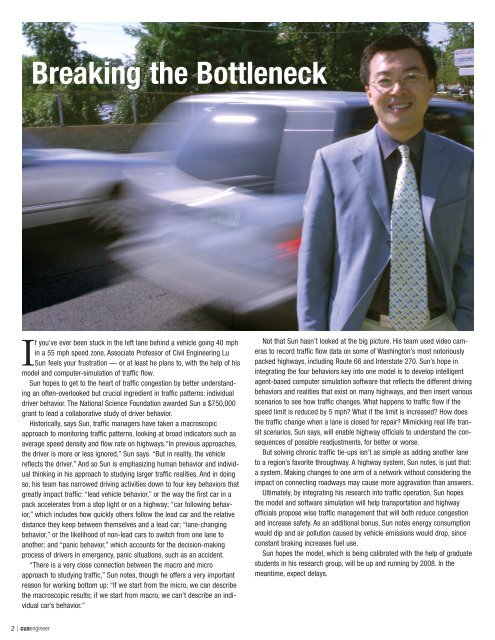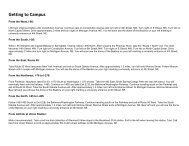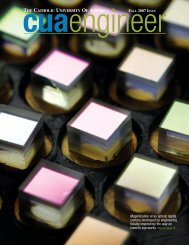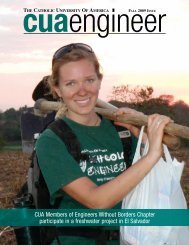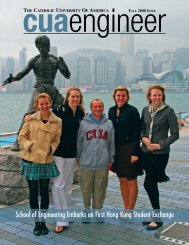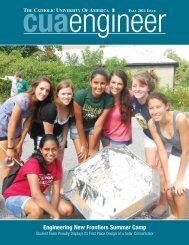inside - the School of Engineering - The Catholic University of America
inside - the School of Engineering - The Catholic University of America
inside - the School of Engineering - The Catholic University of America
Create successful ePaper yourself
Turn your PDF publications into a flip-book with our unique Google optimized e-Paper software.
Breaking <strong>the</strong> Bottleneck<br />
If you’ve ever been stuck in <strong>the</strong> left lane behind a vehicle going 40 mph<br />
in a 55 mph speed zone, Associate Pr<strong>of</strong>essor <strong>of</strong> Civil <strong>Engineering</strong> Lu<br />
Sun feels your frustration — or at least he plans to, with <strong>the</strong> help <strong>of</strong> his<br />
model and computer-simulation <strong>of</strong> traffic flow.<br />
Sun hopes to get to <strong>the</strong> heart <strong>of</strong> traffic congestion by better understanding<br />
an <strong>of</strong>ten-overlooked but crucial ingredient in traffic patterns: individual<br />
driver behavior. <strong>The</strong> National Science Foundation awarded Sun a $750,000<br />
grant to lead a collaborative study <strong>of</strong> driver behavior.<br />
Historically, says Sun, traffic managers have taken a macroscopic<br />
approach to monitoring traffic patterns, looking at broad indicators such as<br />
average speed density and flow rate on highways.“In previous approaches,<br />
<strong>the</strong> driver is more or less ignored,” Sun says. “But in reality, <strong>the</strong> vehicle<br />
reflects <strong>the</strong> driver.” And so Sun is emphasizing human behavior and individual<br />
thinking in his approach to studying larger traffic realities. And in doing<br />
so, his team has narrowed driving activities down to four key behaviors that<br />
greatly impact traffic: “lead vehicle behavior,” or <strong>the</strong> way <strong>the</strong> first car in a<br />
pack accelerates from a stop light or on a highway; “car following behavior,”<br />
which includes how quickly o<strong>the</strong>rs follow <strong>the</strong> lead car and <strong>the</strong> relative<br />
distance <strong>the</strong>y keep between <strong>the</strong>mselves and a lead car; “lane-changing<br />
behavior,” or <strong>the</strong> likelihood <strong>of</strong> non-lead cars to switch from one lane to<br />
ano<strong>the</strong>r; and “panic behavior,” which accounts for <strong>the</strong> decision-making<br />
process <strong>of</strong> drivers in emergency, panic situations, such as an accident.<br />
“<strong>The</strong>re is a very close connection between <strong>the</strong> macro and micro<br />
approach to studying traffic,” Sun notes, though he <strong>of</strong>fers a very important<br />
reason for working bottom up: “If we start from <strong>the</strong> micro, we can describe<br />
<strong>the</strong> macroscopic results; if we start from macro, we can’t describe an individual<br />
car’s behavior.”<br />
Not that Sun hasn’t looked at <strong>the</strong> big picture. His team used video cameras<br />
to record traffic flow data on some <strong>of</strong> Washington’s most notoriously<br />
packed highways, including Route 66 and Interstate 270. Sun’s hope in<br />
integrating <strong>the</strong> four behaviors key into one model is to develop intelligent<br />
agent-based computer simulation s<strong>of</strong>tware that reflects <strong>the</strong> different driving<br />
behaviors and realities that exist on many highways, and <strong>the</strong>n insert various<br />
scenarios to see how traffic changes. What happens to traffic flow if <strong>the</strong><br />
speed limit is reduced by 5 mph? What if <strong>the</strong> limit is increased? How does<br />
<strong>the</strong> traffic change when a lane is closed for repair? Mimicking real life transit<br />
scenarios, Sun says, will enable highway <strong>of</strong>ficials to understand <strong>the</strong> consequences<br />
<strong>of</strong> possible readjustments, for better or worse.<br />
But solving chronic traffic tie-ups isn’t as simple as adding ano<strong>the</strong>r lane<br />
to a region’s favorite throughway. A highway system, Sun notes, is just that:<br />
a system. Making changes to one arm <strong>of</strong> a network without considering <strong>the</strong><br />
impact on connecting roadways may cause more aggravation than answers.<br />
Ultimately, by integrating his research into traffic operation, Sun hopes<br />
<strong>the</strong> model and s<strong>of</strong>tware simulation will help transportation and highway<br />
<strong>of</strong>ficials propose wise traffic management that will both reduce congestion<br />
and increase safety. As an additional bonus, Sun notes energy consumption<br />
would dip and air pollution caused by vehicle emissions would drop, since<br />
constant braking increases fuel use.<br />
Sun hopes <strong>the</strong> model, which is being calibrated with <strong>the</strong> help <strong>of</strong> graduate<br />
students in his research group, will be up and running by 2008. In <strong>the</strong><br />
meantime, expect delays.<br />
2 | cuaengineer


